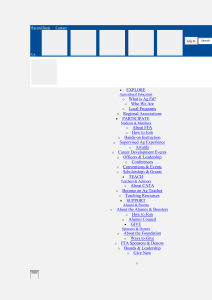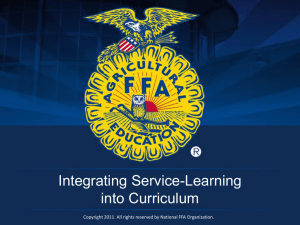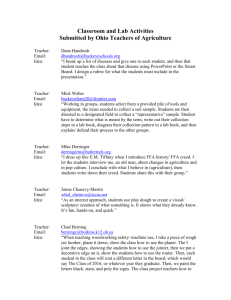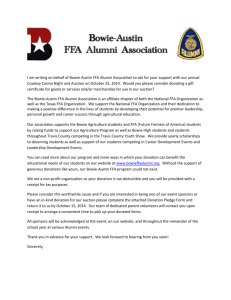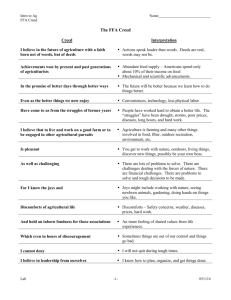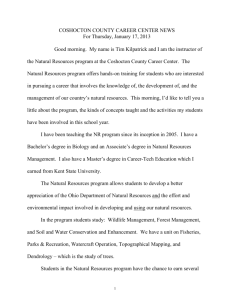Class Objective List
advertisement
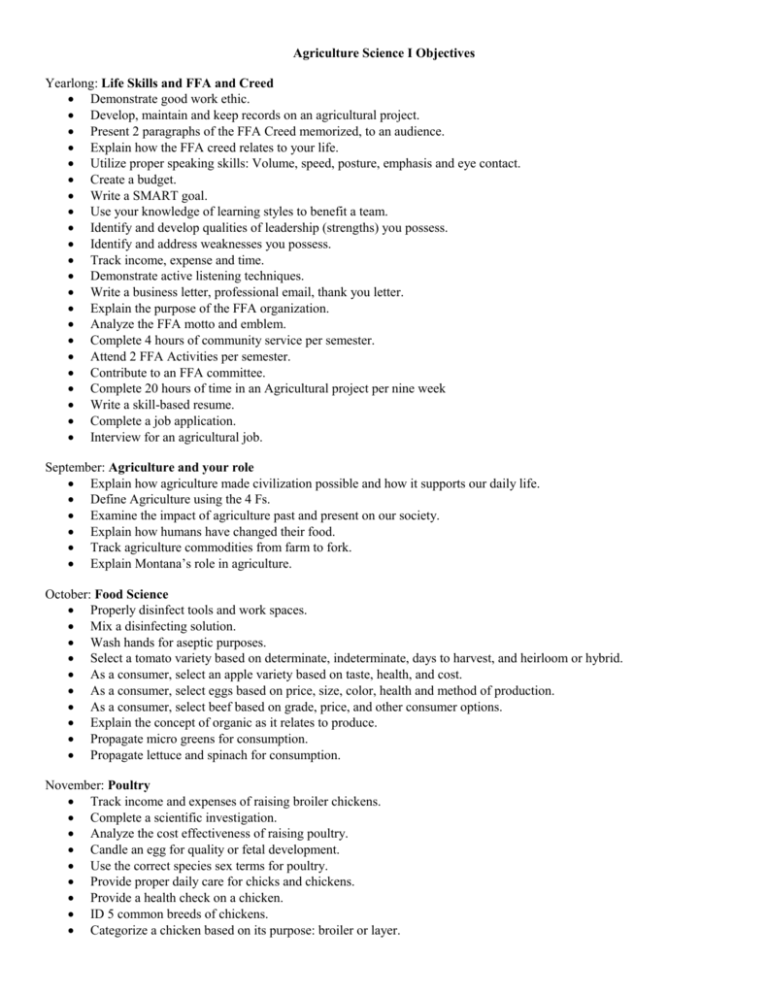
Agriculture Science I Objectives Yearlong: Life Skills and FFA and Creed Demonstrate good work ethic. Develop, maintain and keep records on an agricultural project. Present 2 paragraphs of the FFA Creed memorized, to an audience. Explain how the FFA creed relates to your life. Utilize proper speaking skills: Volume, speed, posture, emphasis and eye contact. Create a budget. Write a SMART goal. Use your knowledge of learning styles to benefit a team. Identify and develop qualities of leadership (strengths) you possess. Identify and address weaknesses you possess. Track income, expense and time. Demonstrate active listening techniques. Write a business letter, professional email, thank you letter. Explain the purpose of the FFA organization. Analyze the FFA motto and emblem. Complete 4 hours of community service per semester. Attend 2 FFA Activities per semester. Contribute to an FFA committee. Complete 20 hours of time in an Agricultural project per nine week Write a skill-based resume. Complete a job application. Interview for an agricultural job. September: Agriculture and your role Explain how agriculture made civilization possible and how it supports our daily life. Define Agriculture using the 4 Fs. Examine the impact of agriculture past and present on our society. Explain how humans have changed their food. Track agriculture commodities from farm to fork. Explain Montana’s role in agriculture. October: Food Science Properly disinfect tools and work spaces. Mix a disinfecting solution. Wash hands for aseptic purposes. Select a tomato variety based on determinate, indeterminate, days to harvest, and heirloom or hybrid. As a consumer, select an apple variety based on taste, health, and cost. As a consumer, select eggs based on price, size, color, health and method of production. As a consumer, select beef based on grade, price, and other consumer options. Explain the concept of organic as it relates to produce. Propagate micro greens for consumption. Propagate lettuce and spinach for consumption. November: Poultry Track income and expenses of raising broiler chickens. Complete a scientific investigation. Analyze the cost effectiveness of raising poultry. Candle an egg for quality or fetal development. Use the correct species sex terms for poultry. Provide proper daily care for chicks and chickens. Provide a health check on a chicken. ID 5 common breeds of chickens. Categorize a chicken based on its purpose: broiler or layer. Correctly and humanely butcher a turkey/ chicken. December: Biotechnology Analyze the benefits of agricultural biotechnology to society. Examine the structure of DNA. Explain how genetic modification is used in agriculture. Explain breed and species. ID top 5 horse and top 4 cattle, sheep, goat, chicken, and pig breeds. Utilize proper species terminology. Create a crossbreed based on desirable traits. Explain how cloning benefits horticulture. Propagate a plant from stem cuttings, leaf cuttings. Graft a tomato. January: Vet Medicine Explain disease transmission. Gauze muzzle a dog Commercial muzzle a dog. ID 16 common vet tools. Use directional terminology. Analyze a dog’s body language and respond appropriately. Apply a standing restraint to a small or medium dog. Apply a sitting restraint to a large dog. Apply a sternal recumbency restraint on a small or medium dog. Fill and read a syringe. Administer an IM shot. Explain the importance of vaccinating on a schedule. Explain anesthesia and why it’s used Putting on and removing clean gloves Wash hands for aseptic purposes. Properly trim a dog’s nails Know the following term: palpate, abscess, colic, TPR, necropsy February: Agriculture Mechanics Draw a blueprint to scale. Accurately use a tape measure. Safely cut using a skill saw. Safely use a cordless drill and screwdriver. Cut and glue PVC pipe based on a blueprint. March: FFA Activities and Community Service March and April: Ornamental Horticulture Explain how a greenhouse works. Explain photosynthesis. ID 16 common greenhouse plants. Recognize signs of underwatering and overwatering. Correctly water a plant. Identify a quality light source. Read a plant label. Explain annual vs perennial Explain the requirements of full sun, part sun and shade. Transplant plugs, plants and tomatoes. Germinate a seed. Mix a potting soil. Pinch a plant to encourage growth. Deadhead a plant to encourage flowering. Plan and propagate a cool season square foot garden. May: Lifeskills
